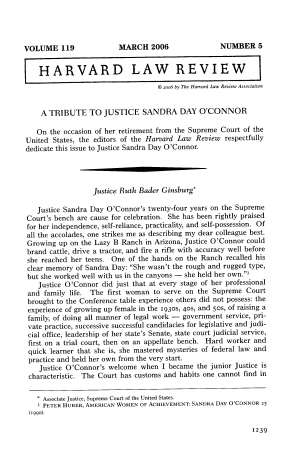A Tribute to Justice Sandra Day O’Connor
March 2006

DISCLAIMER: This text has been transcribed automatically and may contain substantial inaccuracies due to the limitations of automatic transcription technology. This transcript is intended only to make the content of this document more easily discoverable and searchable. If you would like to quote the exact text of this document in any piece of work or research, please view the original using the link above and gather your quote directly from the source. The Sandra Day O'Connor Institute does not warrant, represent, or guarantee in any way that the text below is accurate.
Article Text
(Excerpt, Automatically generated)
VOLUME 119 MARCH 2006 NUMBERS
HARVARD LAW REVIEW
© 2006 by The Harvard Law Review Association
A TRIBUTE TO JUSTICE SANDRA DAY O'CONNOR
On the occasion of her retirement from the Supreme Court of the United States, the editors of the Harvard Law Review respectfully dedicate this issue to Justice Sandra Day O'Connor.
Justice Ruth Bader Ginsburg*
Justice Sandra Day O'Connor's twenty-four years on the Supreme Court's bench are cause for celebration. She has been rightly praised for her independence, self-reliance, practicality, and self-possession. Of all the accolades, one strikes me as describing my dear colleague best. Growing up on the Lazy B Ranch in Arizona, Justice O'Connor could brand cattle, drive a tractor, and fire a rifle with accuracy well before she reached her teens. One of the hands on the Ranch recalled his clear memory of Sandra Day: "She wasn't the rough and rugged type, but she worked well with us in the canyons - she held her own."1
Justice O'Connor did just that at every stage of her professional and family life. The first woman to serve on the Supreme Court brought to the Conference table experience others did not possess: the experience of growing up female in the 1930s, 40s, and 50s, of raising a family, of doing all manner of legal work - government service, pri vate practice, successive successful candidacies for legislative and judi cial office, leadership of her state's Senate, state court judicial service, first on a trial court, then on an appellate
